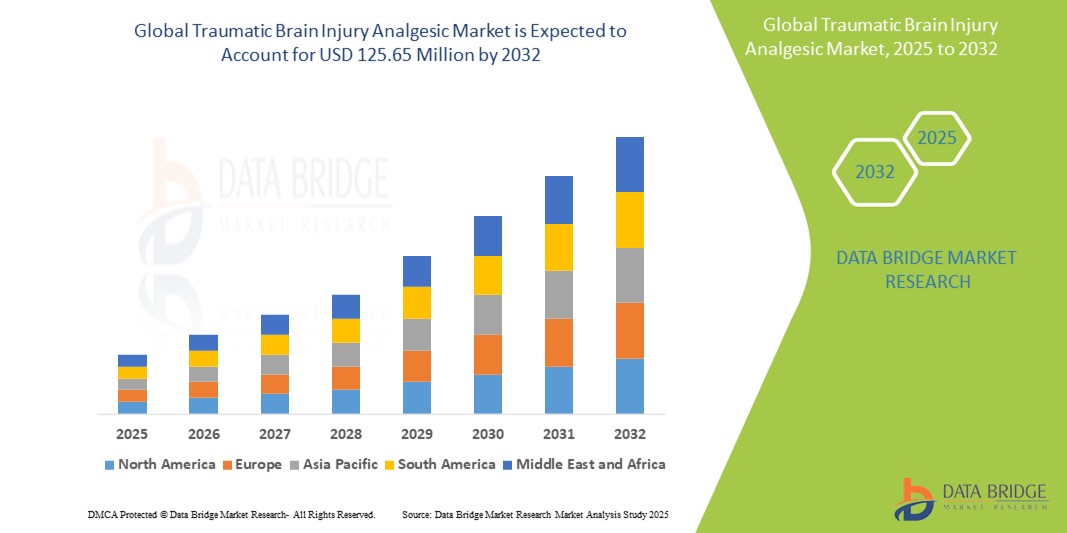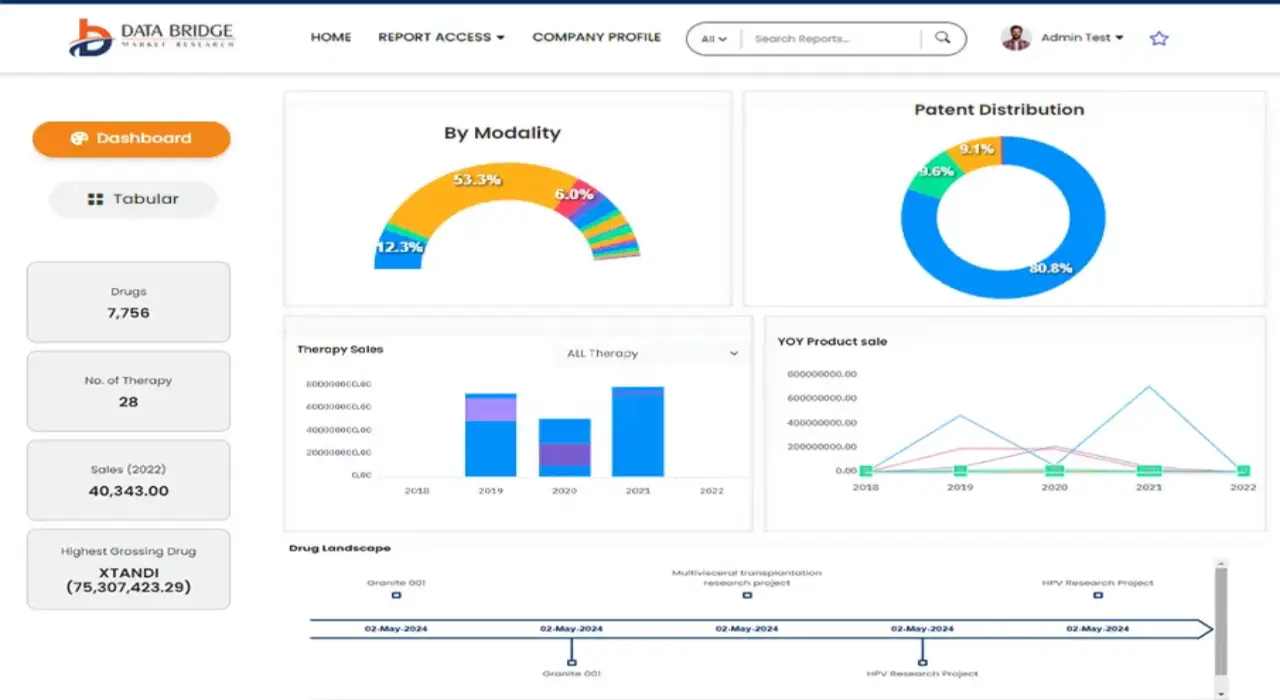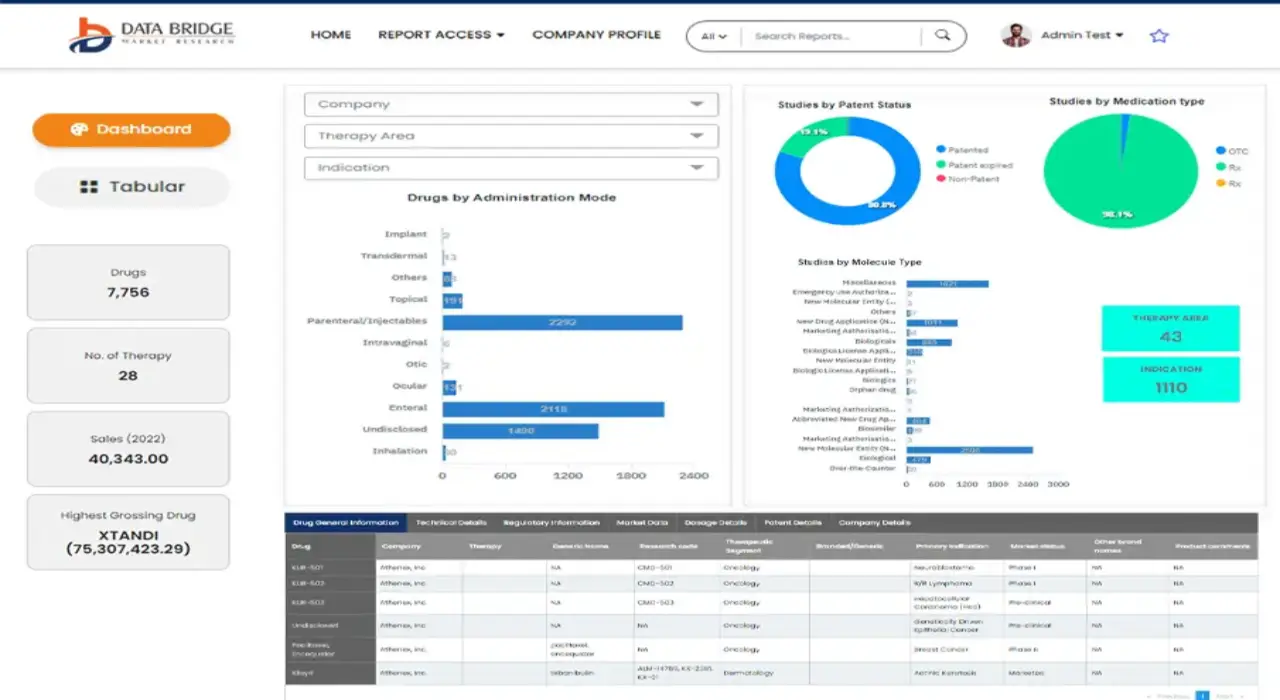Global Traumatic Brain Injury Analgesic Market
Market Size in USD Million
CAGR :
% 
 USD
80.23 Million
USD
125.65 Million
2024
2032
USD
80.23 Million
USD
125.65 Million
2024
2032
| 2025 –2032 | |
| USD 80.23 Million | |
| USD 125.65 Million | |
|
|
|
Global Traumatic Brain Injury Analgesic Market Segmentation, By Analgesic Drug Type (Analgesic combinations, Antimigraine agents, COX-2 Inhibitors, Acetaminophen and Miscellaneous Analgesics, Narcotic Analgesics, Nonsteroidal Anti-Inflammatory Drugs (NSAIDs), and Salicylates), Route-administration (Oral and Parenteral), Distribution Channel (Hospital Pharmacies, Retail Pharmacies, and Online Stores)- Industry Trends and Forecast to 2032
Traumatic Brain Injury Analgesic Market Size
- The global traumatic brain injury analgesic market was valued at USD 80.23 Million in 2024 and is expected to reach USD 125.65 Million by 2032
- During the forecast period of 2025 to 2032 the market is likely to grow at a CAGR of 5.77%, primarily driven by the by rising incidences of traumatic brain injuries and increasing demand for effective pain management solutions
- This growth is driven by factors such as the increasing prevalence of road accidents and sports-related injuries, along with advancements in analgesic drug formulations and growing healthcare investments
Traumatic Brain Injury Analgesic Market Analysis
- Traumatic Brain Injury (TBI) analgesics are vital in managing pain associated with brain injuries, which often result from accidents, falls, or sports injuries. These analgesics play a key role in improving patient outcomes by reducing discomfort during recovery phase
- The demand for TBI analgesics is significantly driven by the rising global incidence of traumatic brain injuries and increased awareness of early and effective pain management. Military personnel, athletes, and road accident victims are among the major affected populations
- North America stands out as one of the dominant markets for TBI analgesics, attributed to its advanced trauma care systems, high healthcare spending, and increasing rates of sports- and accident-related TBIs
- For instance, the U.S. records over 2.8 million TBI-related emergency visits, hospitalizations, and deaths annually, fueling the demand for specialized analgesic treatments across hospitals and trauma center
- Globally, Traumatic brain injury analgesics are recognized as a fundamental component in neurotrauma treatment protocols, with growing integration into post-acute care settings and rehabilitation programs aimed at enhancing patient recovery and quality of life
Report Scope and Traumatic Brain Injury Analgesic Market Segmentation
|
Attributes |
Traumatic Brain Injury Analgesic Key Market Insights |
|
Segments Covered |
|
|
Countries Covered |
North America
Europe
Asia-Pacific
Middle East and Africa
South America
|
|
Key Market Players |
|
|
Market Opportunities |
|
|
Value Added Data Infosets |
In addition to the insights on market scenarios such as market value, growth rate, segmentation, geographical coverage, and major players, the market reports curated by the Data Bridge Market Research also include import export analysis, production capacity overview, production consumption analysis, price trend analysis, climate change scenario, supply chain analysis, value chain analysis, raw material/consumables overview, vendor selection criteria, PESTLE Analysis, Porter Analysis, and regulatory framework. |
Traumatic Brain Injury Analgesic Market Trends
“Growing Shift Toward Multimodal Pain Management Approaches”
- One prominent trend in the global traumatic brain injury analgesic market is the increasing shift toward multimodal pain management strategies that combine various classes of analgesics to optimize pain relief while minimizing side effects
- This approach integrates non-opioid medications such as NSAIDs, anticonvulsants, and antidepressants alongside or in place of traditional opioids to target different pain pathways and reduce dependency risks
- For instance, combinations of acetaminophen and gabapentinoids are being used more frequently in TBI cases to address both nociceptive and neuropathic pain, offering more comprehensive and personalized treatment options
- There is also a growing emphasis on personalized medicine, where analgesic regimens are tailored based on the severity of the injury, patient response, and genetic factors affecting drug metabolism
- This trend is transforming the standard of care in TBI recovery, improving pain control, reducing adverse effects, and driving demand for a broader range of innovative analgesic solutions in the market
Traumatic Brain Injury Analgesic Market Dynamics
Driver
“Rising Incidence of Traumatic Brain Injuries Across All Age Groups”
- The growing global incidence of traumatic brain injuries, resulting from road accidents, falls, sports injuries, and combat-related trauma, is significantly contributing to the increased demand for effective analgesic treatments
- TBIs are becoming more prevalent across all age groups, particularly among children, young adults involved in high-risk activities, and the elderly population prone to falls, which amplifies the need for efficient pain management solutions
- Mild to severe TBIs often lead to acute and chronic pain, necessitating the use of specialized analgesics to improve patient comfort, facilitate rehabilitation, and prevent complications such as chronic pain syndromes or psychological distress
- The Medical advancements have expanded the availability of targeted and non-opioid pain therapies, making analgesics a critical component in the standard care pathway for TBI recovery
- As the awareness around TBI and its long-term impact grows, the focus on timely pain control and quality of life post-injury is accelerating market demand for analgesics tailored to neurotrauma cases
For instance,
- According to the Centers for Disease Control and Prevention (CDC), in the U.S. alone, there are over 220,000 TBI-related hospitalizations annually, with millions more treated in emergency departments—highlighting the massive demand for acute pain management solutions
- In a 2023 study published in The Lancet Neurology, it was noted that global TBI cases are expected to rise sharply due to increasing urbanization and vehicular density, further driving the need for scalable and effective analgesic options in both developed and developing nations
- As TBIs continue to represent a significant public health concern worldwide, the rising number of cases is directly propelling the demand for innovative and safer analgesic therapies, shaping the market's long-term growth trajectory
Opportunity
“Emergence of AI and Digital Health Tools in Personalized Pain Management”
- The integration of artificial intelligence (AI) and digital health technologies presents a significant opportunity to advance personalized pain management in traumatic brain injury (TBI) care. These tools can analyze patient-specific data to optimize analgesic regimens and monitor treatment responses in real-time
- AI-driven platforms are increasingly being developed to assess patient-reported outcomes, vital signs, and behavioral data, enabling clinicians to adjust pain management strategies dynamically and reduce the risks of overmedication or adverse effects
- In addition, wearable and mobile health technologies can help track patient pain levels, medication adherence, and neurological symptoms, allowing for more precise and proactive management of pain post- traumatic brain injury
For instance,
- In a 2024 study published in Frontiers in Pain Research, AI models were successfully used to predict chronic pain development in TBI patients by analyzing clinical data, imaging results, and genetic markers—enabling early intervention and personalized treatment planning
- In October 2023, the NIH launched a digital health initiative aimed at integrating AI-powered tools in post-acute care settings to support remote pain monitoring and optimize medication use for TBI patients, highlighting the growing interest in digital therapeutics
- The application of AI and digital technologies in TBI pain management holds the potential to enhance treatment efficacy, minimize dependency on opioids, and improve long-term patient outcomes. This shift toward data-driven, individualized care is expected to create new growth avenues in the TBI analgesic market over the coming years
Restraint/Challenge
“High Development Costs and Regulatory Barriers for New Analgesics”
- The high cost and complexity associated with developing and bringing new analgesic drugs to market pose a significant challenge, particularly within the context of traumatic brain injury (TBI), where safety, efficacy, and neurotoxicity concerns are paramount
- Research and clinical trials focused on TBI-specific pain management often require extensive resources and time due to the variability of injury severity, patient response, and the neurological risks associated with certain drug classes, especially opioids and CNS-active agents
- These challenges are further amplified by stringent regulatory frameworks, which demand rigorous testing and long-term outcome data to ensure new therapies do not exacerbate brain injury or lead to adverse neurological effects
For instance,
- In a 2023 report by the Pharmaceutical Research and Manufacturers of America (PhRMA), it was noted that the average cost of bringing a new central nervous system (CNS)-targeted drug to market exceeds $2 billion, largely due to high failure rates and complex clinical trial designs
- According to the U.S. FDA, analgesic treatments for TBI must meet enhanced neurotoxicity and addiction risk standards, often resulting in prolonged approval timelines and increased costs for drug manufacturers
- Consequently, smaller pharmaceutical companies may be discouraged from investing in the TBI analgesic space, slowing innovation and limiting the availability of novel, targeted pain therapies. This financial and regulatory burden continues to constrain market growth, especially in regions with limited healthcare funding or pharmaceutical infrastructure
Traumatic Brain Injury Analgesic Market Scope
The market is segmented on the basis of analgesic drug type, route-administration, and distribution channel.
|
Segmentation |
Sub-Segmentation |
|
By Analgesic Drug Type |
|
|
By Route-Administration |
|
|
By Distribution Channel
|
|
Traumatic Brain Injury Analgesic Market Regional Analysis
“North America is the Dominant Region in the Traumatic Brain Injury Analgesic Market”
- North America dominates the traumatic brain injury (TBI) analgesic market, driven by advanced healthcare infrastructure, high adoption of innovative pain management solutions, and a well-established trauma care system
- U.S. holds a significant share due to its high incidence of TBIs, particularly in sports, military, and road traffic accidents, as well as the rising prevalence of neurotrauma in the aging population. Continued advancements in pain management strategies, including opioid alternatives and non-pharmacological approaches, further boost market growth
- The strong government and healthcare funding for TBI research, along with the presence of leading pharmaceutical companies and research institutions, support the development and approval of new analgesic treatments
- In addition, the increasing adoption of personalized pain management approaches and multimodal analgesic strategies in trauma centers across the region is contributing to the expanding market for TBI-specific pain management solutions
“Asia-Pacific is Projected to Register the Highest Growth Rate”
- Asia-Pacific is expected to witness the highest growth rate in the TBI analgesic market, driven by rapidly expanding healthcare infrastructure, growing awareness about traumatic brain injuries, and rising surgical and rehabilitation volumes
- Countries such as China, India, and Japan are emerging as key markets due to the growing number of accidents, increasing participation in high-risk sports, and the rising prevalence of TBIs in the elderly population
- Japan, with its advanced medical infrastructure and increasing focus on neurotrauma care, remains a significant market for TBI analgesics, particularly in developing more targeted and non-opioid pain management therapies.
- China and India, with their large populations and rising rates of traffic accidents and sports injuries, are witnessing increased investment in trauma care, rehabilitation facilities, and pharmaceutical research, contributing to the rapid growth of the analgesic market for TBI patients. The improving accessibility to healthcare services and the presence of global pharmaceutical companies in the region further enhance market prospects
Traumatic Brain Injury Analgesic Market Share
The market competitive landscape provides details by competitor. Details included are company overview, company financials, revenue generated, market potential, investment in research and development, new market initiatives, global presence, production sites and facilities, production capacities, company strengths and weaknesses, product launch, product width and breadth, application dominance. The above data points provided are only related to the companies' focus related to market.
The Major Market Leaders Operating in the Market Are:
- Pfizer Inc. (U.S.)
- Johnson & Johnson Services, Inc. (U.S.)
- Lilly (U.S.)
- Sanofi (France)
- GSK plc. (U.K.)
- Novartis AG (Switzerland)
- Teva Pharmaceutical Industries Ltd. (Israel)
- Bayer AG (Germany)
- AbbVie Inc. (U.S.)
- Boehringer Ingelheim International GmbH (Germany)
- Sun Pharmaceutical Industries Ltd. (India)
- AstraZeneca (U. K.)
- Mallinckrodt (Ireland)
- Endo, Inc. (Ireland)
- Dr. Reddy’s Laboratories Ltd. (India)
- UCB S.A. (Belgium)
- Purdue Pharma L.P. (U.S.)
- Ipsen Pharma (France)
- Zydus Group (India)
- Amneal Pharmaceuticals LLC (U.S.)
Latest Developments in Global Traumatic Brain Injury Analgesic Market
- In January 2025, The U.S. Food and Drug Administration (FDA) approved Suzetrigine (brand name Journavx) for the treatment of moderate to severe acute pain in adults. Suzetrigine is the first non-opioid pain medication in two decades to receive FDA approval, functioning as a selective NaV1.8 ion channel inhibitor, providing effective pain relief without the risks associated with opioids
- In January 2025, SanBio's SB623, a stem cell-based therapy for chronic motor deficits from TBI, showed promising Phase 2 clinical trial results. Patients receiving SB623 implants showed significant improvements in motor function. This positions SB623 as a potential game-changer for neuroregenerative treatments for TBI
- In December 2024, Pinteon Therapeutics' monoclonal antibody PNT001, targeting phosphorylated tau (pT231), progressed to Phase 1b trials. This novel approach aims to mitigate tau-related neurodegeneration following TBI and offers a potential treatment for cognitive impairments in TBI patients
- In October 2024, The University of California, San Francisco (UCSF) initiated a clinical trial to evaluate the efficacy of atorvastatin, candesartan, and minocycline for treating mild to moderate TBI. These drugs, shown to reduce brain inflammation in preclinical studies, are being tested for their potential to improve recovery from TBI
- In September 2024, AI algorithms and advanced imaging technologies are revolutionizing TBI diagnosis and treatment. AI is now being used to predict patient outcomes and personalize treatment plans, while quantitative imaging techniques are enhancing the precision of TBI assessments. These advancements are leading to more effective interventions and improved patient outcomes
SKU-
Get online access to the report on the World's First Market Intelligence Cloud
- Interactive Data Analysis Dashboard
- Company Analysis Dashboard for high growth potential opportunities
- Research Analyst Access for customization & queries
- Competitor Analysis with Interactive dashboard
- Latest News, Updates & Trend analysis
- Harness the Power of Benchmark Analysis for Comprehensive Competitor Tracking
Research Methodology
Data collection and base year analysis are done using data collection modules with large sample sizes. The stage includes obtaining market information or related data through various sources and strategies. It includes examining and planning all the data acquired from the past in advance. It likewise envelops the examination of information inconsistencies seen across different information sources. The market data is analysed and estimated using market statistical and coherent models. Also, market share analysis and key trend analysis are the major success factors in the market report. To know more, please request an analyst call or drop down your inquiry.
The key research methodology used by DBMR research team is data triangulation which involves data mining, analysis of the impact of data variables on the market and primary (industry expert) validation. Data models include Vendor Positioning Grid, Market Time Line Analysis, Market Overview and Guide, Company Positioning Grid, Patent Analysis, Pricing Analysis, Company Market Share Analysis, Standards of Measurement, Global versus Regional and Vendor Share Analysis. To know more about the research methodology, drop in an inquiry to speak to our industry experts.
Customization Available
Data Bridge Market Research is a leader in advanced formative research. We take pride in servicing our existing and new customers with data and analysis that match and suits their goal. The report can be customized to include price trend analysis of target brands understanding the market for additional countries (ask for the list of countries), clinical trial results data, literature review, refurbished market and product base analysis. Market analysis of target competitors can be analyzed from technology-based analysis to market portfolio strategies. We can add as many competitors that you require data about in the format and data style you are looking for. Our team of analysts can also provide you data in crude raw excel files pivot tables (Fact book) or can assist you in creating presentations from the data sets available in the report.













